I like a good conspiracy theory as much as anyone—as long as it makes sense. I believe President Kennedy was killed by multiple gunmen who were likely paid by the mob. I don’t believe the conspiracy theory that Adolph Hitler escaped to South America.
I suppose I should point out that the subject of today’s blog post could realistically be classified as a conspiracy theory since there isn’t any verifiable official documentation to substantiate its claims. However, this is one of those theories that might have some backbone based on circumstantial evidence.
Did You Know?
Here’s a question to test your knowledge about World War II:
Which countries did the United States formally declare war against after the Japanese bombed Pearl Harbor on 7 December 1941?
(a) Germany, France & Japan
(b) Grand Fenwick, Elbonia & Lilliput
(c) Japan, Germany & Italy
(d) Australia, New Zealand & Russia
The Woodrow Wilson National Fellowship Foundation did a survey of American citizens with questions taken from the U.S. Citizenship Test. Sixty-percent failed to identify the three countries in the above question (I made up three of the four; obviously, the third choice or, C is the correct answer). Additionally, only 13% knew when the U.S. Constitution was ratified, 57% couldn’t say how many justices sat on the U.S. Supreme Court, and only 24% could identify something Benjamin Franklin was famous for—37% thought he invented the light bulb.
I will leave any conclusions up to you.
The American Marshall Plan
As a backdrop, let’s look at the Foreign Assistance Act of 1948 also known as the Marshall Plan. Approved by President Harry Truman and Congress in April 1948, it was named after General George C. Marshall, arguably one of Roosevelt and Truman’s best advisors (General Marshall was Truman’s Secretary of State when he pushed for the draft and approval of the plan). The goal of the Marshall Plan was to simply aid Western and Eastern European countries with economic assistance to rebuild their infrastructures. Listen to General Marshall’s Harvard speech in 1947 here.
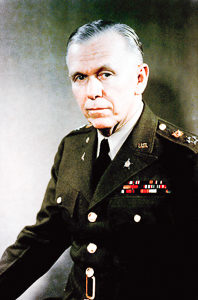
Truman and Marshall had two overriding reasons to see this plan approved: first, they saw it as an investment in Eastern European countries as a way to thwart Soviet influence (Stalin ultimately refused to accept any American money for his satellite countries) and second, Marshall was keenly aware of the ramifications from World War I and the Versailles Treaty when the victors demanded unrealistic reparations without assisting Germany to get back on its feet.
The Marshall Plan operated for four years with aid totaling $17 billion or more than $194 billion in today’s dollars. It was replaced at the end of 1951 with the Mutual Security Plan which donated $7 billion on an annual basis. This lasted until 1961 when that plan was replaced by another economic assistance program.
The Marshall Plan was extraordinary in its vision to the future. It is highly probable that the only reason Europe recovered so quickly (not only its infrastructure but also its economy) after such a devastating war was because of American assistance—seventy years later, Germany has the strongest economy in the EU.
However, there is a strong possibility that before the war ended, the Nazis recognized the same thing about Germany and its need for post-war assistance. In their minds however, it would be former Nazis who would plan for the rebirth of Germany with the intent to wait for the Fourth Reich to rise from the ashes.
German Industrialists
It is no secret that most of Germany’s most powerful industrialists supported Hitler and the Nazi regime. Hitler gave a speech to the Industrialist Club on 27 January 1932 as he was running for the presidency in the March 1932 elections. This speech impressed those in attendance and the future Führer immediately gained the support of many German industrialists. Hitler came in second behind the incumbent president, Paul von Hindenburg. However, Hindenburg was persuaded by Hitler’s friends to appoint him chancellor on 30 January 1933. One month later, Hindenburg suspended German citizens’ civil liberties and Hitler began his march to dictatorship and his quest for the Thousand Year Reich, not to mention his place in history as the greatest mass murderer.
On 20 February 1933, twenty-four of the most prominent German industrialists were invited to a meeting at the official residence of the President of the Reichstag, Hermann Göring. This was nothing more than a fundraising event for the purpose of supporting the Nazi Party in the March 1933 election. Hjalmar Schacht (1877−1970), Hitler’s future Minister of Economics, stood up after the speeches were completed and requested the group donate three million Reichsmarks to the campaign. These men did not disappoint Hitler or Göring—records show that two million Reichsmarks were donated at this meeting (Gustav Krupp contributed half).
Several of the prominent industrialists who attended this meeting included the following:
Gustav Krupp (1870−1950): The Krupp family ran its 400-year-old heavy industrial conglomerate from the city of Essen. The company manufactured steel, artillery, ammunition, and other armaments. It was one of the major contributors to the Nazis’ war effort with its production of battleships, U-boats, tanks, and hundreds of other lethal weapons. Hitler named Krupp as chairman of the “Reich Federation of German Industry” and almost immediately, Krupp fired all the Jews from his companies. Under the Third Reich, the company expanded its payroll from thirty-five thousand to more than 112,000 employees. Gustav Krupp was in failing health by the time war began in 1939 and subsequently turned the responsibility for running the company in 1943 to his son, Alfried, following a stroke two-years earlier. By the end of the war, Krupp was senile and an invalid, making it impossible for the Allies to try him at the main Nuremberg trial despite his indictment for war crimes and crimes against humanity (Gustav Krupp is the only German to be named a war criminal after the end of both world wars). Learn more about the Krupp trial here.
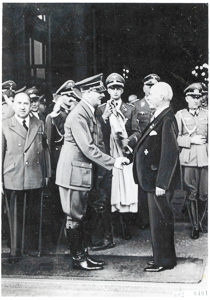
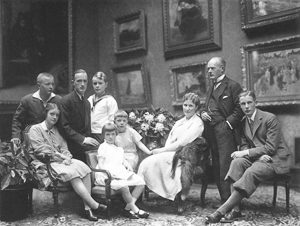
Günther Quandt (1881−1954): Quandt founded the family industrial empire that today, includes the German car manufacturer, BMW. His second marriage in 1921 was to Magda Ritschel. They had a son, Harald, who, along with his half-brother Herbert, would succeed Günther in running the family conglomerate after the war. Divorced in 1929, Magda remarried two years later to Dr. Joseph Goebbels with Adolf Hitler serving as the best man. Günther joined the Nazi party in 1933 and placed his companies at the forefront of the German war efforts including the manufacture of ammunition, rifles, artillery, and batteries. Three of his factories used slave labor and in one factory, an execution area was set up. Hitler appointed Quandt as the Nazi party’s Wehrwirtschaftsführeror, “Leader in the War Economy.”
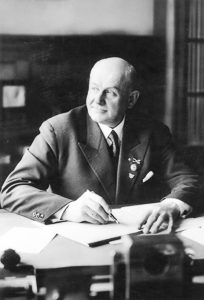
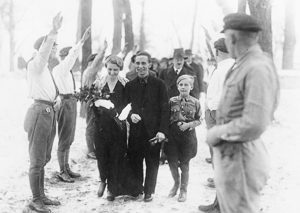
Friedrich Flick (1883−1972): Like most of his fellow industrialists, Flick built his fortune during the first world war. He became one of the prominent German industrialists asked to join the “Circle of Friends of Heinrich Himmler” for the purpose of providing financial support to Himmler. The Flick Group was the leading conglomerate in the coal and steel industries and considered one of the primary industrial manufacturers supporting the war effort. Like most of the major German companies, forced labor was used in its mines and factories with the knowledge of Flick and his management team.
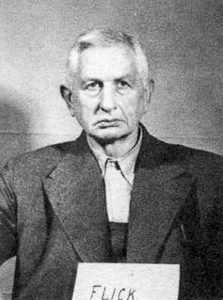
Georg von Schnitzler (1884−1962): Schnitzler was a board member of IG Farben during the Nazi era. IG Farben supplied its patented poison gas Zykon B to the Nazis for use in the gas chambers at Auschwitz, Buchenwald, and other extermination camps. During the occupations of Poland and France, Schnitzler and IG Farben took over foreign chemical factories. Schnitzler became aware of the “Final Solution” when he was promoted to be chairman of IG Farben’s Chemical Committee. By 1939, the company had been purged of all Jewish directors, key executives, and shareholders. Its leaders were fully on board with Hitler, his war plans, and the use of forced labor from the concentration camps at most of its production facilities. They opened the IG Farben Buna-N plant known as Monowitz Buna Werke several miles from Auschwitz II-Birkenau (the extermination camp). Inmates from Auschwitz were worked to death (or executed) while producing synthetic rubber. Additionally, IG Farben staff was used to conduct medical experiments on the inmates at the Mauthausen concentration camp. It was common knowledge at the time that the executives and directors of IG Farben knew about the mass killings and their role in perpetrating these crimes. Learn more about IG Farben here.
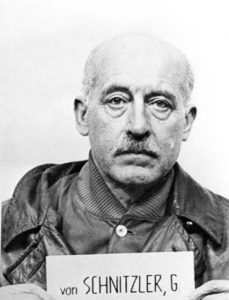
Carl Friedrich von Siemens (1872−1941): Carl Friedrich von Siemens ran Siemens & Halske AG (today known as Siemens AG or Siemens), a conglomerate specializing in electrical and electronic products as well as construction of electrical power plants. A strong supporter of Hitler and the war, von Siemens died in September 1941. His nephew, Hermann von Siemens (1885−1986), succeeded him as Chairman of Siemens & Halske AG. Under Hermann’s guidance, the company became notorious for its complicity with the Nazis. Siemens built the gas chambers used in the extermination camps. It was one of the leading companies using the Nazi “Death Through Work Program,” a system of killing slave laborers through inhumane work conditions. By the end of the war, Siemens had more than 400 factories “employing” 50,000 concentration camp inmates. Many of the factories had been set up inside or near camps such as Auschwitz, Buchenwald, Flossenberg, and Ravensbrück, just to name a few. The company also grew during the twelve years between 1933 and 1945 as a result of the expropriation of Jewish-owned businesses.
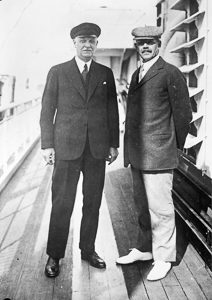
The Red House Meeting
U.S. Military Intelligence Report EW-Pa 128 was issued on 27 November 1944 from Melvin M. Fagen. It was addressed to Walter K. Schwinn, G-2, Economic Section with a copy to Supreme Headquarters Allied Expeditionary Force (SHAEF), Office of Assistant Chief of Staff, G-2 (that would have been Major General Kenneth Strong).
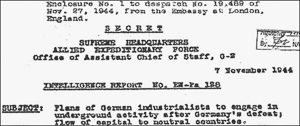
Also known as The Red House Report, it was based on the first-hand accounts from a reportedly reliable long-time agent of the French Deuxième Bureau (the French intelligence agency and comparable to the British MI5 and MI6). The report outlined a meeting held in Strasbourg at the Maison Rouge Hotel (Red House Hotel) on 10 August 1944 where German industrialists planned to engage in secret activities following Germany’s defeat. They were to create front companies and immediately set up the flow of capital out of Germany into neutral countries (I believe today we call that money laundering). They were also to arrange for substantial loan packages to be accessed after Germany’s surrender. In other words, the Nazi Party would go underground, the industrialists would rebuild Germany’s economy, and once conditions were right, the Nazis would take over once more but this time as the Fourth Reich.
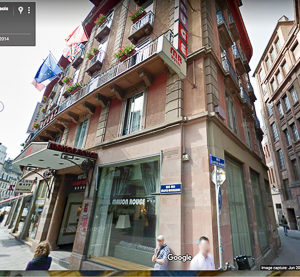
The meeting was conducted by SS Obergruppenführer Dr. Scheid, a position inferior only to Himmler. Also represented at the meeting was a German Naval Ministry official, and Dr. Strossner of the Ministry of Armament. Companies represented at this meeting included Krupp, Messerschmitt, Volkswagenwerk, Röchling, Rheinmetall, and Bussing. Krupp was to work with U.S. Steel Corporation, Carnegie Illinois, and American Steel and Wire. It was pointed out that the Zeiss Company, Leisa Company, and the Hamburg-American Line had been especially effective in protecting their interests abroad. It was especially important that these German companies establish technical and research facilities in foreign countries but ensure these entities could not be traced directly to Germany.
The Nazi Party guaranteed payment to the industrialists once the country was back on its feet and the party was re-established as the government.
Nuremberg
Dr. Scheib told the attendees of the Red House meeting that the top Nazi leaders would likely be tried as war criminals but the underlings would receive better treatment. In hindsight, this is true. The main Nuremberg trial saw twenty-four of the surviving Nazi brass indicted as war criminals, including Gustav Krupp. Unfortunately, the paperwork was drawn up incorrectly because the Allies meant to put his son, Alfried, in the dock of the main trial and not his father since Gustav was unfit to stand trial.
After the main trial, there were twelve subsequent trials run by the Americans. Three of these trials dealt with the industrialists. The majority of indictments were for crimes against humanity. The charges stemmed primarily from these companies using forced labor; typically, inmates from the concentration camps.
Case No. 5 was the “Flick Trial” with its six defendants including Friedrich Flick who was found guilty and received a seven-year sentence (he served less than three years). Flick was indicted and convicted of crimes against humanity, “plundering,” and being a member of the SS, a designated criminal organization. The other defendants were all directors of the Flick Group; three were acquitted while the other two received relatively short sentences.
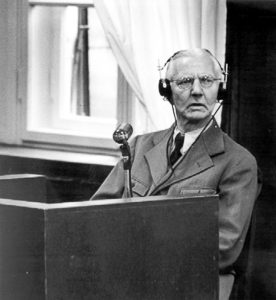
Case No. 6 was the “IG Farben Trial” with its twenty-three defendants. Ten men were acquitted while the others received sentences ranging from one and a half to ten years—no one served longer than two years except for Otto Ambrose (click here to read the blog Hang ‘Em or Hire ‘Em). Georg von Schnitzler was convicted and sentenced to five years but only served one year.
Case No. 10 was the “Krupp Trial” where Alfried Krupp (1907−1967) was the primary defendant along with eleven others from his executive team. Krupp was found guilty of crimes against humanity as well as plundering and sentenced to twelve years in prison as well as having his property confiscated. He served only three years because John McCloy, the U.S. High Commissioner for Germany, pardoned Krupp, restored his property, and allowed Krupp to return to the company and rebuild it. Alfried Krupp was extremely close to the Nazi party and especially Himmler (Alfried joined the SS in 1931). He demanded slave labor from the camps (including children) to work in his factories even when the military insisted Krupp use “free” Germans due to security issues (Krupp paid the SS four Reichsmarks per laborer). Krupp knew Germany would lose the war and began liquidating personal assets in 1942. He secretly moved the cash over-seas which funded his return to German society after being released from prison.
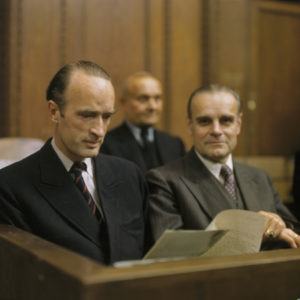
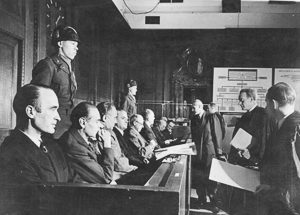
Postwar
It is an indisputable fact that powerful Nazi-era bankers, industrialists, and civil servants either got a pass for their actions or received very light sentences which were quickly commuted or pardoned. These former Nazis and fascists became reborn democrats. Watch the prisoners being released in 1951 here.
Immediately after the war, Krupp began rebuilding. It ultimately became one of, if not, the wealthiest corporations in Europe. By 1999, it had merged with Thyssen AG to form ThyssenKrupp AG. Today, it is one of the largest conglomerates in the world. Alfried Krupp ultimately transferred ownership of the company to a foundation and his heirs relinquished any claims on the business.
After the war ended, Günther Quandt was arrested because of his ties to Joseph and Magda Goebbels and not because of any slave labor or criminal issues. Quandt was released in early 1948 without being charged for war crimes. After Quandt died, his two sons, Herbert (by Günther’s first wife) and Harald (his mother was Magda), split up their inheritance of more than two hundred companies. While the two were jointly responsible for the entire company, Herbert (1910−1982) concentrated on AFA/VARTA, Daimler-Benz, and the subsequent purchase of BMW while Harald (1921−1967), who was a Luftwaffe fighter pilot, became responsible for IWKA and the engineering and tooling companies. After the war, the family refused to acknowledge or admit to any involvement with the Nazi regime. It was only when the award-winning documentary, The Silence of the Quandts, aired in 2007 and outlined the role the Quandt family businesses played in Nazi Germany did the family order an exhaustive study into its past. The resulting 1,200-page report released in 2011 found that “The Quandts were linked inseparably with the crimes of the Nazis” including the appropriation of Jewish-owned businesses. More than half of the slave laborers used in Quandt factories died of inhumane conditions or execution. To my knowledge, while the Quandts have acknowledged the family’s Nazi past, none of them have ever formally apologized. Watch The Silence of the Quandts video here, English sub-titles.
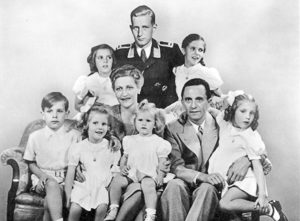
Three-quarters of the Flick Group assets were lost to the Soviets due to their locations in the Soviet-Occupied Zone. The coal business was sold to meet the post-war requirement that the company sell either the coal or steel businesses. Friedrich Flick walked out of prison in 1950 after serving less than two years of his original 7-year sentence and one of Germany’s wealthiest individuals and largest shareholder in Daimler-Benz. West Germany heaped numerous awards on him in the 1950s and 1960s.
Georg von Schnitzer was released from prison after serving less than a year of his original 5-year sentence. He returned to the business world as the president of an organization which promotes understanding between Germany and South American countries. IG Farben was liquidated by the Allies in the sense it was broken up into multiple companies such as Agfa, BASF, and Bayer.
Carl Friedrich von Siemens did not live to see the end of the war but his nephew, Hermann von Siemens, did. Hermann was arrested by the Allies and but no charges were ever filed against him. Hermann returned as the head of Siemens in 1948. In 2001, Siemens AG tried to trademark the word “Zyklon” as part of their push to sell a new line of products: gas ovens. Siemens responded to the expected outcry that they never drew the connection that everyone else seemed to know.
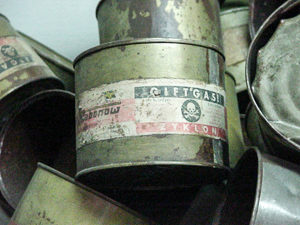
These are just a few of those austere capitalists who attended the fund-raising meeting for the Nazis in 1933 and went on to prolong the war with their industrial might. There are twenty attendees I could outline along with companies such as Volkswagen, Hugo Boss, Kodak, Bayer, Ford, Standard Oil, and Chase Bank, all of whom had direct connections with the Third Reich.
One thing that cannot be disputed is the fact that these men left their families and heirs with fortunes that have made them some of the wealthiest people in Germany if not the world.
Conspiracy Theory or Not?
I think there is enough circumstantial evidence to support U.S. Military Intelligence Report EW-Pa 128. Heinrich Himmler, Chief of the SS, unsuccessfully attempted to negotiate a separate peace with the Allies in April 1945. He likely knew by late 1944 that Germany would lose the war. Himmler always saw himself as Hitler’s successor so it wouldn’t be out of line to suppose SS Obergruppenführer Scheid was ordered by his boss to come up with a clandestine plan to finance the rebuilding of post-war Germany and ultimately, the re-emergence of the Nazi party. Himmler could then take on the role he envisioned would be his.
Heinrich Himmler committed suicide. However, after the war ended, leading bankers, industrialists, and former Nazis became instrumental in reviving the West German economy and its political agenda as well as working to unite Europe.
I guess it was kind of like the Marshall Plan but with a more sinister motivation which fortunately, never materialized.
Recommended Reading and Viewing
US Military Intelligence Report EW-Pa 128 Read it here.
Lebor, Adam. The Budapest Protocol. London: Reportage Press, 2009.
Mr. Lebor claims to have discovered US Military Intelligence Report EW-Pa 128 during his research for his novel, The Budapest Protocol. Serious historians seem to be skeptical of its authenticity.
One thing about conspiracy theories is that no one is right and no one is wrong. It’s sort of like an opinion.
What’s New With Sandy and Stew?
There are a lot of sea days during our Amazon River trip. I plan on making the most of my time working on the new book, Where Did They Put the Gestapo Headquarters? A Walking Tour of Nazi Occupied Paris (1940-1944).
Someone Is Commenting On Our Blogs
If there is a topic you’d like to see a blog written about, please don’t hesitate to contact me. I love hearing from you so keep those comments coming.
Why Would You Want To Buy Our “Walks Through History” Books?
Simple.
You like to travel and experience history and historical events. You like to see original buildings that had a significant impact on the people and events of the history you’re engaged with. You want to know the stories behind the brick and mortar in front of you.
The walking tour books are meticulously researched so you can go directly to those sites and learn about the building’s history as well as an introduction to some of the more interesting people associated with it.
Thank You
Sandy and I appreciate you visiting with us. We have some exciting things on the horizon and we’ll keep you updated as we go along.
Share This:
Follow Stew:
Find Stew’s books on Amazon and iBooks.
Please note that we do not and will not take compensation from individuals or companies mentioned or promoted in the blogs.
Walks Through History
Copyright © 2018 Stew Ross

